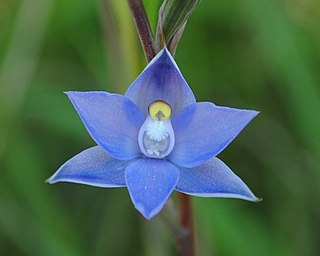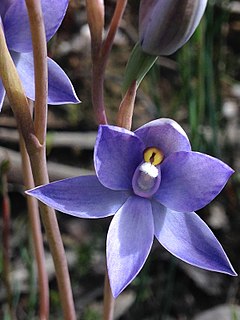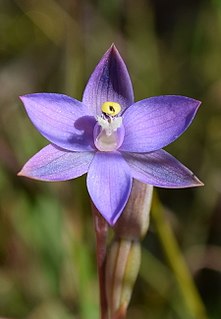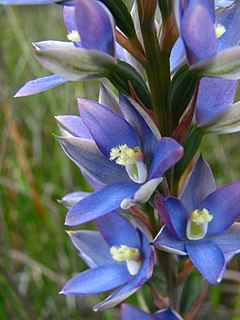
Thelymitra macrophylla, commonly called the large-leafed sun orchid or scented sun orchid, is a species of flowering plant in the orchid family Orchidaceae, and is endemic to the south-west of Western Australia. It has a single thick, broad, leathery leaf and up to twenty five relatively large dark blue to purplish flowers with white, toothbrush-like tufts.

Thelymitra nuda, commonly known as the plain sun orchid is a species of orchid that is endemic to eastern Australia. It has a single fleshy, channelled leaf and up to twelve dark blue to purplish, sometimes white or pinkish flowers with white tufts on top of the anther. It grows in a range of habitats and sometimes forms large colonies.
Thelymitra frenchii, commonly called the scarp sun orchid or Jarrahdale sun orchid, is a species of orchid in the family Orchidaceae and endemic to a small area in the south-west of Western Australia. It has a single long, fleshy leaf and up to three relatively small, blue flowers.

Thelymitra megacalyptra, commonly called the plains sun orchid, is a species of orchid that is endemic to eastern Australia. It has a single erect, fleshy leaf and up to fifteen blue to purplish, sometimes lilac, pink or white flowers with white tufts on top of the anther. It is known as Thelymitra megcalyptra by some authorities.
Thelymitra albiflora, commonly called the white sun orchid, is a species of orchid that is endemic to South Australia. It has a single erect, narrow, fleshy leaf and up to ten relatively small white flowers with white toothbrush-like tufts on top of the anther.

Thelymitra arenaria, commonly called the forest sun orchid, is a species of orchid that is endemic to south-eastern Australia. It has a single long, narrow leaf and up to sixteen purplish self-pollinating flowers which only open on hot days.
Thelymitra exigua, commonly called the short sun orchid, is a species of orchid that is endemic to south-eastern Australia. It has a single fleshy, channelled, dark green leaf and up to eight relatively small pale blue flowers with white toothbrush-like tufts on top of the anther.

Thelymitra granitora, commonly called the coastal granite sun orchid or coastal sun orchid, is a species of orchid in the family Orchidaceae and is endemic to the south-west of Western Australia. It has a single short, curved and channelled dark green leaf and up to eight relatively large pale blue or white, self-pollinating flowers with white mop-like tufts on the top of the anther.
Thelymitra planicola, commonly called the glaucous sun orchid, is a species of orchid that is endemic to southern eastern Australia. It has a single erect, leathery, channelled, dark green leaf and up to twelve blue flowers with darker veins. The plant has a bluish green hue and the flowers are self-pollinating, only opening widely on hot days.
Thelymitra vulgaris, commonly called the slender sun orchid or common sun orchid, is a species of orchid in the family Orchidaceae and endemic to the south-west of Western Australia. It has a single erect, dark green leaf and up to nine relatively small, blue to purplish or white flowers.
Thelymitra xanthotricha, commonly called the yellow tufted sun orchid or yellow tufted slender sun orchid, is a species of orchid in the family Orchidaceae and endemic to the south-west of Western Australia. It has a single erect, fleshy, channelled, dark green leaf and up to six relatively large dark blue to purplish flowers.

Thelymitra mucida, commonly called the plum sun orchid or plum orchid, is a species of orchid that is endemic to southern Australia. It has a single erect, fleshy, linear leaf and up to six blue, purplish or plum coloured flowers with a thick, sticky secretion on the anther lobe.

Thelymitra canaliculata, commonly called the flushed sun orchid or blue sun orchid is a species of orchid in the family Orchidaceae and is endemic to the south-west of Western Australia. It has a single erect, fleshy leaf and up to twenty eight blue flowers with darker veins and sometimes flushed with pink. The lobe on top of the anther is blackish with a yellow crest.
Thelymitra latiloba, commonly called the wandoo sun orchid or wandoo shirt orchid, is a species of orchid in the family Orchidaceae and endemic to the south-west of Western Australia. It has a single erect, fleshy, channelled, dark green leaf and up to twelve blue flowers with darker blue veins and sometimes flushed with mauve. The lobe on top of the anther is wavy.
Thelymitra occidentalis, commonly called the western azure sun orchid or rimmed orchid, is a species of orchid in the family Orchidaceae and is endemic to the south-west of Australia. It has a single erect, fleshy, channelled, dark green leaf and up to fifteen blue flowers with darker blue veins and sometimes flushed with pink. The lobe on top of the anther has a wavy, yellow crest.
Thelymitra cornicina, commonly called the lilac sun orchid, is a species of orchid in the family Orchidaceae and is endemic to the south-west of Western Australia. It has a single narrow, pale green leaf and up to eight lilac-tinged blue flowers with the lobe on top of the anther covered with short, finger-like calli.

Thelymitra circumsepta, commonly called the naked sun orchid, is a species of orchid that is endemic to south-eastern Australia. It has a single leathery, dark green leaf and up to twenty blue to purplish or pink flowers with fringed lobes and yellowish hair tufts on top of the column.
Thelymitra atronitida, commonly called the black-hooded orchid, is a species of orchid that is endemic to south-eastern Australia. It has a single erect, leathery, leaf and up to eight moderately dark blue, self-pollinating flowers that only open on hot days.

Thelymitra petrophila, commonly known as the granite sun orchid, is a species of orchid that is endemic to Western Australia. It has a single erect, channelled, long light green leaf and up to ten or more pale blue to mauve or pink flowers. It grows in drier area, usually in shallow soil pockets on granite outcrops.
Thelymitra paludosa, commonly known as the plain sun orchid, is a species of orchid that is endemic to Western Australia. It has a single erect, channelled, dark green leaf and up to ten or more blue to violet flowers. It grows in higher rainfall areas near the south coast.










